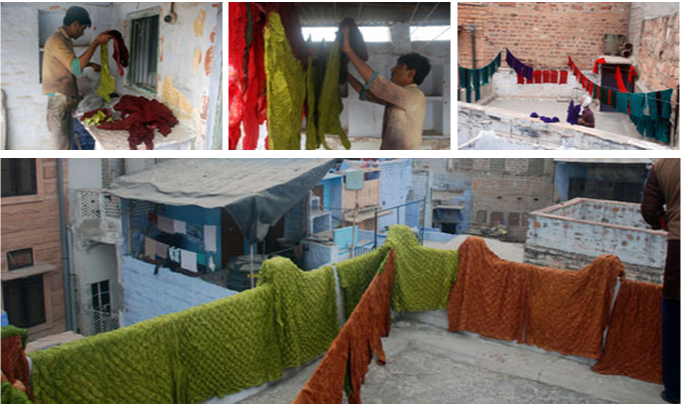
The art of Bandhej or Bandhani is a highly skilled process requiring time and patience. This technique of dyeing fabric involves tightly tying textiles using wires, threads, stones, grains like cereals, rice etc.When fabric is dipped into color and allowed to dry, it gives miraculous results after un-tying it.
Types of Tie and Dye
Mothda - The fabric is tied or folded in such a way that it forms wave pattern after opening the folds and knots. The opposite ends of the fabric are pulled and rolled together so that it forms a checker effect but in opposite diagonal pattern.
Leheria - Leheria means waves in hindi, is a dyeing technique in which fabric is rolled diagonally from one corner to the other corner to the selvedge and tied at regular intervals before dyeing. This gives waves like pattern or lines going across the fabric.
Bandhani - In this process, the pattern on the fabric is first marked and then tied in small knots. To give the pattern uniform look, amateurs may use cereals (yellow dal) to tie.
 |
 |
|
Existence and use of traditional bandhani or tie and dye has been traced as far back as 5000 years ago. Among various types of tie & Dye processes,’Bandhani’ is the oldest and the most popular tie and dye tradition that is still in practice.
According to craftrevival.org “Ancient artists discovered that some dyes dissolve and gave their color readily to water, forming a solution which was easily absorbed by the fabric. Herbs and plants like turmeric and indigo were crushed to a fine powder and dissolved in water so that cotton material could be dyed in deep colors”
Although it is difficult to trace the origins of this beautiful craft, from some reliable sources such as wikipedia it is believed to be introduced to Kutch from Sindh by muslim Khatris.
Bandhani, in its present form is practiced widely in Rajasthan (Barmer, Jaipur, Sikar, Jodhpur, Pali, Jaipur, Udaipur, Nathwada and Bikaner). Motifs and colors of Bandhani may change based on region to region. It is a well known fact that a Bandhani artisan can be easily recognized by looking at his finger. Artisans grow nail of the little finger or wear a metal guard ring to facilitate easily picking the fabric for tying.

Bandhani is performed either on cottons or silks such as muslin, handloom, georgette, chiffon, crepe etc. Traditional dyes have been replaced from synthetic dyes due to many reasons such as cost, easy procurement and time involved in the process.

It is really interesting to see that how two different fabrics dipped in the same dye solution can differ in color dramatically. Final outcome may vary drastically and depends on the texture and type of fabrics.

Revival Of The Craft
However, the demand of Bandhani is increasing in International market, it is an art that requires more attention than it is getting at present. In India, Bandhani is less popular among middle class and rather more appreciated by higher class who loves the modern form of Bandhani produced by Indian fashion designers. Indian government is promoting the artisans and their craft through government websites, providing them financial loans and enabling them to interact with the world by introducing them to the internet. With help of non-government organizations and government initiatives, it has become possible to bring more and more Bandhani artisans online. Although, artisans have to a long way to go before they reclaim the old glory and respect that they used to get from maharajas in old days but it can be said that they have come a long way and making their presence felt through these beautiful textiles on ramps, households and museums around the world.



Comments
Correct concept